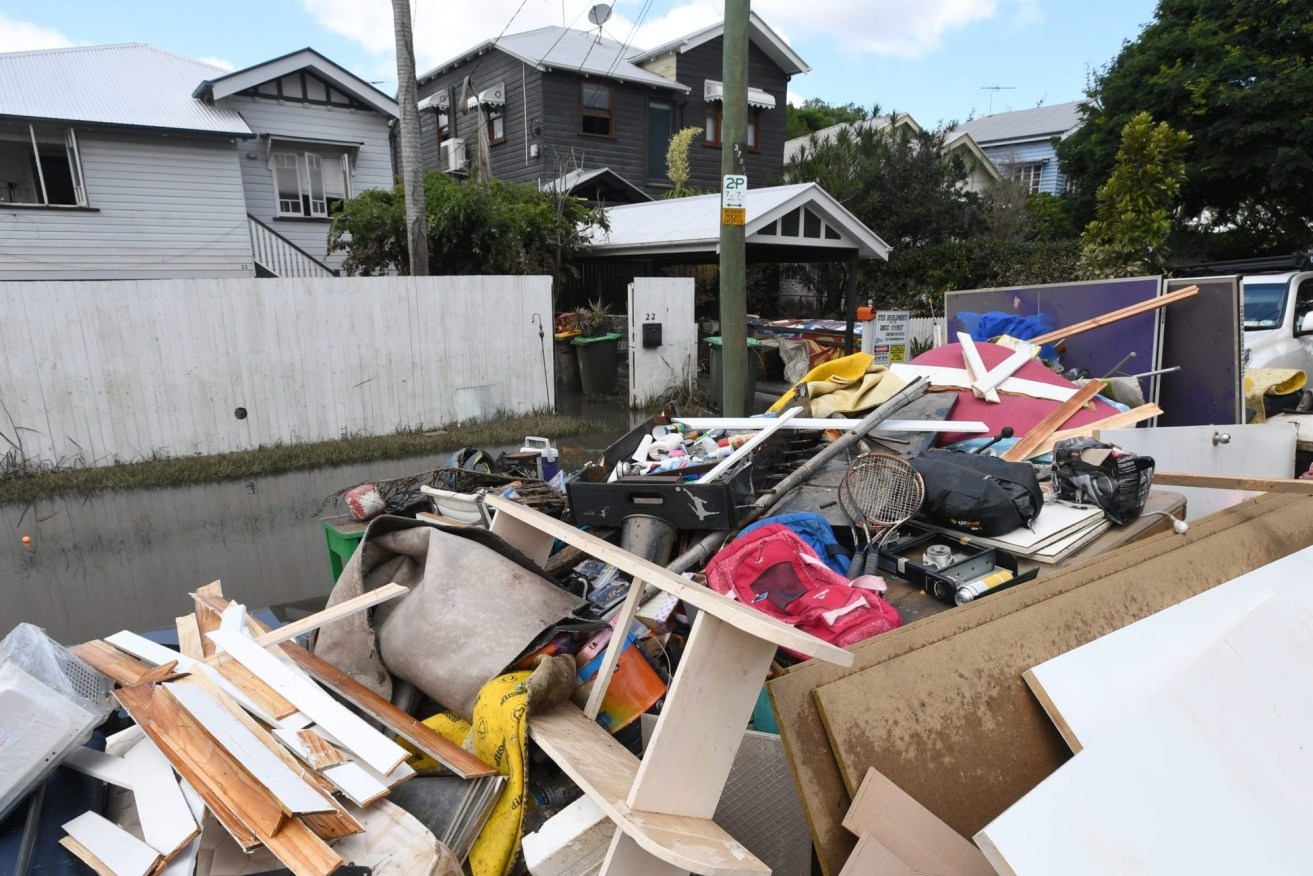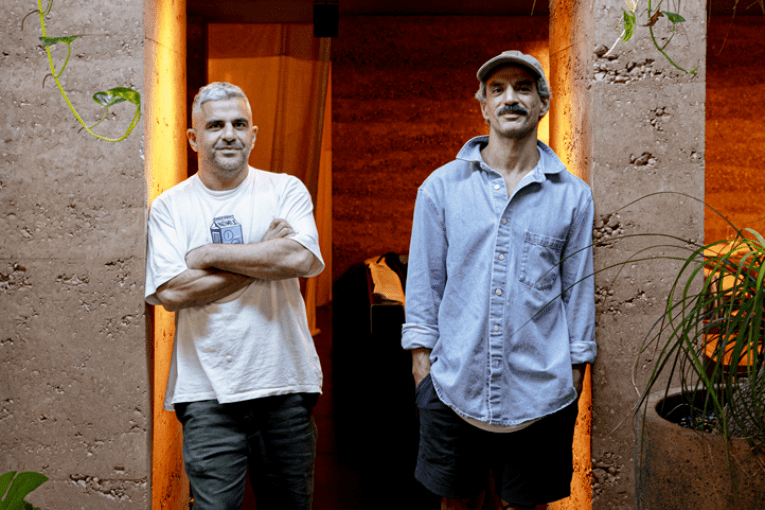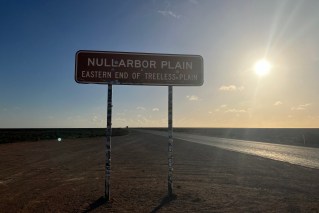A series of unfortunate events: The inside story of how one hail storm triggered state’s housing crisis
Homelessness, a rental crisis, cost blowouts, construction company collapses and millions lost … it all started with a hail storm and went downhill from there.


Flood damaged properties in Auchenflower. Insurance costs have skyrocketed in the city this year (AAP Image/Darren England)
The result of a whole series of events has led to the collapse of at least 15 major construction companies on the east coast. Deposits disappeared along with the dreams of families hoping to build a home.
Vacancy rates are at astonishingly low levels and rents are at record highs. The real estate market has dried up, but fresh hopes are emerging for a slow recovery.
Since 202o very little has gone right, except for the pandemic-inspired spike in house values and a renovation boom, but even they have been problematic.
Master Builders Queensland chief executive Paul Bidwell said that in retrospect there were a lot of signs of things going wrong, even before the crippling hikes in interest rates.
The first sign of trouble was a hail storm in Rockhampton in 2020 that damaged a swag of roofs, then there was the Halloween hail storm in Brisbane’s western corridor which was in the middle of a Homebuilder-inspired boom, which was designed to stimulate the industry during Covid, but created a headache.
Hundreds of buildings were damaged in the storm and insurance companies “moved heaven and earth” to fix them.
“Roofers walked off and said they were going to the insurance companies and that was across SEQ,” Bidwell said.
Then there were the Brisbane floods, which later became the northern NSW Floods. That left hundreds of people homeless and soaked up rental supply. Building materials couldn’t move from southern states.
Because people couldn’t rent they transitioned more quickly to be buyers, something that is still happening as migrants land in Australia and can’t find accommodation.
Then there was the pandemic and border closures and then the Ukraine invasion which blew out timber costs. Add to that the labour shortage which was exaggerated by the abrupt halt of immigration during Covid. That meant some building companies like Tamawood just didn’t work in areas where they couldn’t get labour.
In one year (2022) building costs jumped 18 per cent. Over three years it was 43 per cent, according to Bidwell.
On top of the wave of interstate migrants coming to Queensland, about 400,000 immigrants are now expected to make Australia their home this year. By 2027 that will be 1.5 million and if Queensland gets 20 per cent it’s an extra 300,000 people.
The alarming thing is that there are nowhere near enough houses being built to meet the current demand and much less so to meet future demand. And that’s a problem for the broader economy because the construction sector is such a big generator for businesses like retail. When housing goes well, so too does a lot of the economy as people buy new furniture and appliances for a new home.
Bidwell says that the underlying demand is there and that meant houses would have to be built. The problem, he says, it there is a wariness, a suspicion that another hike in interest rates is around the corner or that house prices will fall or something else will go wrong.
Considering what the world has been through it’s not irrational.
Others point to the big slump in approvals for dwellings which means that some time in the next year, when builders work their way through the backorders, the music will stop.
Dwelling commencements this year in Queensland are expected to be 37,000. Next year it is forecast to drop to 31,000. Bidwell says about 40,000 is a healthy supply-demand level and it won’t reach that level until 2026. That’s a problem because by then it will be five years of below-par dwelling commencements.
And people have stopped selling. The advertised real estate listing levels in Brisbane are down 39 per cent on the five-year average, according to CoreLogic’s Tim Lawless.
He said the 9 per cent fall in Australia’s housing market had appeared to have bottomed-out, but the levels of immigration were going to weigh heavily on the market.
“Immigration is running headlong into a lack of supply,” Lawless said.
The Property Council chief executive Mike Zorbas said immigration numbers showed there were large numbers of new people Australia needed to accommodate.
“Without proper state housing targets, improved planning systems and well-located housing choices for students, retirees and renters we will see the national housing deficit blow out further,” Zorbas said.
“We need a redoubling of national and state commitments to better planning and housing delivery starting now.”
The State Government is not sitting around, but its plans to deal with the crisis are not immediate and stimulating the market with another Homebuilder program would create a bigger problem.
Surprisingly, Bidwell remains optimistic about the industry.
“We are not in crisis. Alarmed, concerned but not in crisis,” he said.
He believes that if interest rates stablise and house prices don’t fall, the market will recover.
Although there have been a big number of building companies hitting the wall it was nowhere near as bad as what many thought would happen.
“It’s nowhere near the precipice we were on in 2019 when we thought the world was going to fall in. Covid hit and the world changed. Covid exacerbated it early on but then people flocked to Queensland,” he said.
“The world did turn on its axis a bit.”
There were now some encouraging signs. The real estate market has stabilised and Brisbane was now seeing price growth, albeit small. Interest rates are at or near the top of the current cycle.
And the industry is not calling for any Government stimulus to the sector because builders were still busy. They may not be profitable but they are busy.
Bidwell said there were problems ahead, as well. One was a Government reform addressing the accessibility of homes which will help people stay in their homes as they age. There are also energy efficiency improvements and together they will add about $20,000 to the cost of a home build when they come into effect in October.
Public Works Minister Mick de Brenni said the suggestion that the implementation of equitable and modern accessibility measures would increase house prices for new builds by $20,000 was wrong, and in fact, the actual upfront cost range as determined by independent modelling commissioned by the Australian Building Code Board is $2900 and $4300 – approximately 1 per cent of the building cost.
He said it would save up to 95 per cent of the cost of retrofitting.
“This is about making homes more accessible, more sustainable, and more inclusive, and ensuring Queensland’s ageing population can be accommodated at home, for longer – taking pressures off the aged care, and health systems.”












